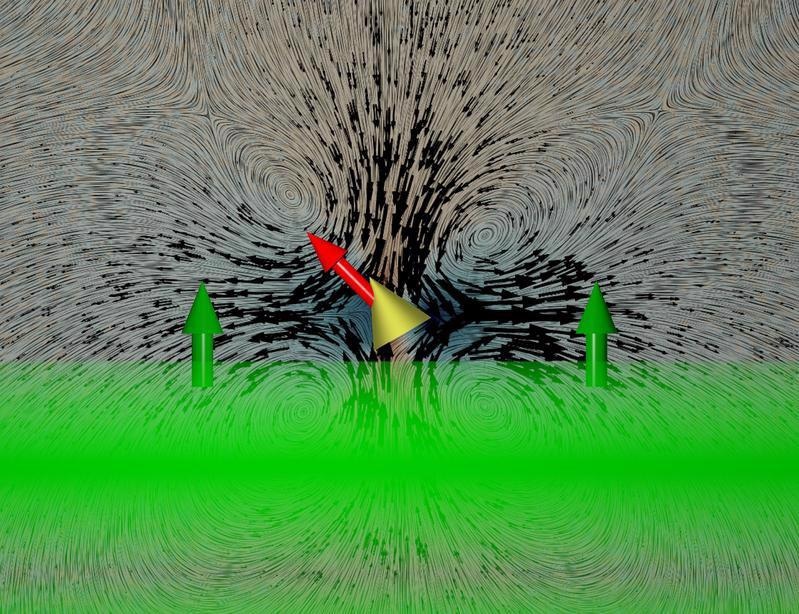A recent article published in the journal ACS Nano examined how the motion of triangular nano- and microparticles, which are established to have a functional and efficient sonic propulsion and are thus appealing candidates for future projects, is dependent on their direction to the propagation path of a traveling ultrasonic wave.

A conical nanoparticle (gold-coloured) in water. The particle is exposed to an ultrasound wave (green). Study: Orientation-Dependent Propulsion of Triangular Nano- and Microparticles by a Traveling Ultrasound Wave. Image Credit: Münster University – Wittkowski working group
Earlier research on ultrasonic-propelled nano- and microparticles has focused only on configurations in which the particulate alignment is orthogonal to the ultrasound propagation path. However, these nanoparticles will likely be able to adopt alternative configurations in future developments.
What are Ultrasound Propeller Nano- and Microparticles?
The breakthrough of propelling microparticles by ultrasound without the need for fuel brought major applications of productive particles forward. These particles have applications in medicine, including that of precise administration of drugs, and materials engineering, where they might be used to create nanomaterials with unique features.
Ultrasound-propelled nanoparticles are more appropriate for medical uses than other propulsion methods previously established because acoustic propulsion is nontoxic and enables nanoparticles to be continuously provided with energy.
Limitations of Previous Studies
Ultrasonic nano- and microparticles have a great deal of promise for commercialization, resulting in excessive research into their characteristics. However, one major issue is that virtually all present research examines a stationary ultrasound pulse, even though a migrating ultrasound wave is considerably more practical for future uses.
Another issue is that in earlier research, the particles were oriented orthogonally to the ultrasound propagation path. Although it is anticipated that in potential developments, the particles will be able to orient themselves differently once they travel, such as within a vehicle suspension system or a patient's arterial wall.
The reason for focusing exclusively on orthogonal directions thus far is that in experiments conducted, samples are floated in the datum plane of a stationary ultrasound wave, which is orthogonal to the ultrasound wave's propagation path, constraining the particles' movement and alignment to that plane.
Present Study on Ultrasound Propelled Triangular Particles
In this work, the researchers take a significant step forward by investigating the sonic acceleration of particles subjected to a planar moving ultrasonic wave capable of orienting in any orientation according to the ultrasonic wave.
The team explored how the movement of potential triangular nanoparticles relies on the reference frame of particle and acoustic waves. Direct computational fluid dynamics simulations based on the nonlinear Navier-Stokes models are used to determine the transmission of the ultrasound and its interactions with a particulate for this objective.
These simulations produce sound-induced stresses and rotational torque occurring on the particle, determining its rotational and translational propelling speed.
Research Findings and Conclusion
The researchers discovered that the particle's momentum is affected by its direction. This is a trait that has an intriguing effect on particle movements, as has lately been explored employing particles with a unique propulsion source.
The specific orientation dependency of the propulsion on particles was shown and simple mathematical formulas for it were supplied. Based on the particle's direction, the velocity profile may appear in any orientation, even antiparallel to the acoustic waves. This discovery is critical for future applications because it demonstrates that ultrasound-propelled nanoparticles may travel directly toward the origin of the ultrasound.
The flow field surrounding the particle seems to be fairly identical for all of its configurations. This suggests that the particle cannot be classified as a pusher, as previously supposed.
On the other hand, it appears that the flow field may be described by a pusher-like fluid domain that moves with the particles but has a fixed direction. When separate ultrasound-propelled particles are not too near, it should be able to calculate the spatially time-averaged hydraulic dynamics between them using this flow field approach.
Future Perspective
Future research should consider investigating changes to crystalline structure, particle density, ultrasonic intensity, ultrasonic amplitude, and other control variables to see how they affect a particle's flexibility to shift perpendicularly to the ultrasonic direction of wave propagation or the fixed points of the particulate alignment.
The team notes that higher-resolution calculations or tests to see if the orientation-averaged propulsion of nanoparticles is existent would also be beneficial.
Reference
Voß, J., and Wittkowski, R. (2022). Orientation-Dependent Propulsion of Triangular Nano- and Microparticles by a Traveling Ultrasound Wave. ACS Nano. Available at: https://pubs.acs.org/doi/10.1021/acsnano.1c02302
Disclaimer: The views expressed here are those of the author expressed in their private capacity and do not necessarily represent the views of AZoM.com Limited T/A AZoNetwork the owner and operator of this website. This disclaimer forms part of the Terms and conditions of use of this website.